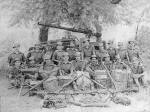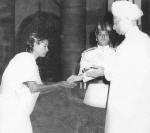The Bangladesh War 1971
Battle of Sylhet
- Details
- Created: 18 December 2015
- Written by Brigadier Rattan Kaul (4/5 Gorkha Rifles (Frontier Force))
- Hits: 86243
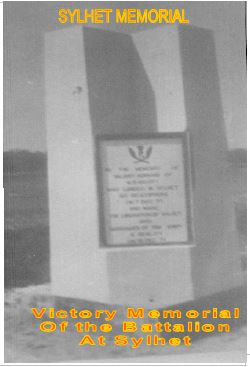
Brigadier Rattan Kaul, commissioned and commanded 4/5 GR (FF) brings the account of the Heliborne Operations at Sylhet which led to an early surrender at Dacca. He was Forward Rifle Company Commander (Delta Company) during the Battle of Sylhet and was seriously injured in the Battle. He was also the assault company commander during the Khukri assault on Atgram.
Battle of Atgram
- Details
- Created: 09 October 2015
- Written by Brigadier Rattan Kaul (4/5 Gorkha Rifles (Frontier Force))
- Hits: 89145
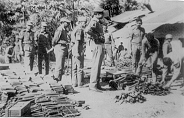
Brigadier Rattan Kaul brings the account of a Khukri assault launched by his battalion, which annihilated a full company of 31 Punjab Pakistan Army. The battalion infiltrated behind the Pakistan Defenses to launch the classical attack.
The author was Assault Rifle Company Commander during the Battle of Atgram.
Heliborne Operations by Sylhet Gorkhas Leads to Early Surrender at Dacca
- Details
- Created: 08 April 2015
- Written by Brigadier Rattan Kaul, 4/5 Gorkha Rifles (Frontier Force)
- Hits: 34998
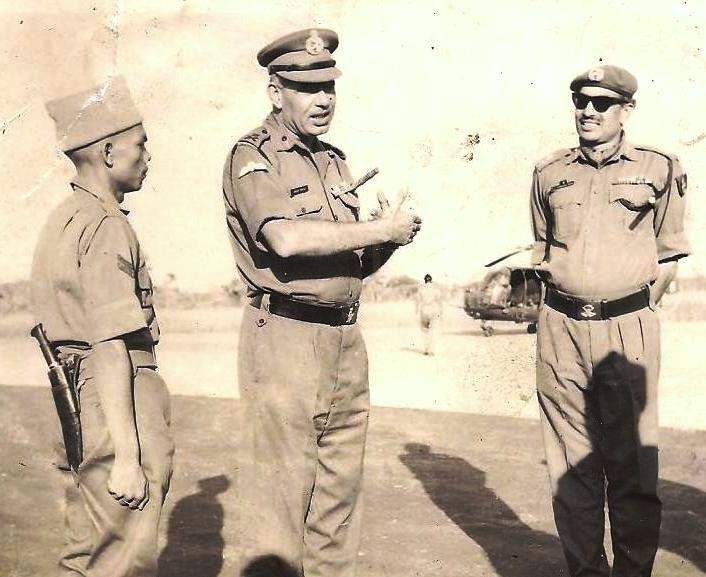
Brigadier Rattan Kaul chronicles the operations carried out by the Sylhet Gurkhas (4/5 Gorkha Rifles (Frontier Force)) during the war in 1971 and how it led to the surrender of Dacca.
Official History of the 1971 India Pakistan War
- Details
- Created: 12 October 2006
- Written by History Division
- Hits: 53927
© History Division, Ministry of Defence, Government of India. Adobe Acrobat Reader is required to view these file. Two files (Introduction.pdf & Chapter 1.pdf) were received in a corrupted state from the original source and are included here only for the sake of completion.
Introduction.pdf: File Size - 1.6M
Foreword.pdf: File Size - 95k
Preface.pdf: File Size - 277k
Abbreviations.pdf: File Size - 393k
Appendix.pdf: File Size - 2.3M
Bibliography.pdf: File Size - 240k
List of Persons Interviewed.pdf: File Size - 129k
•Chapter01.pdf: File Size - 1.2M
•Chapter02.pdf: File Size - 2.9M
•Chapter03.pdf: File Size - 1017k
•Chapter04.pdf: File Size - 3.0M
•Chapter05.pdf: File Size - 2.0M
•Chapter06.pdf: File Size - 5.0M
•Chapter07.pdf: File Size - 2.7M
•Chapter08.pdf: File Size - 4.5M - Pakistan Choses War : Operations in J & K
•Chapter09.pdf: File Size - 3.8M - Pakistan Choses War : Operations in J & K
•Chapter10.pdf: File Size - 2.5M - The Indian Air Force in the West
•Chapter11.pdf: File Size - 1.5M - Naval Operations in the Arabian Sea
•Chapter12.pdf: File Size - 3.4M - All Out War in Bangladesh
•Chapter13.pdf: File Size - 2.7M - March to Dhaka
•Chapter14.pdf: File Size - 1.8M - IAF in the Eastern Theatre
•Chapter15.pdf: File Size - 2.3M - The Indian Navy in the Bay of Bengal
•Chapter16.pdf: File Size - 2.4M - The Pakistani Surrender
•Chapter17.pdf: File Size - 2.2M - Politics in the United Nations
•Chapter18.pdf: File Size - 2.0M - In Search of Lasting Peace
•Chapter19.pdf: File Size - 1.1M - Review and Reflections
1971 War: Dhaka or Bust?
- Details
- Created: 16 December 2011
- Written by Sumit Walia
- Hits: 49372
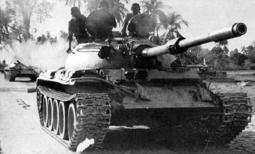 Was Army HQ in 1971 so blind that they failed to identify Dhaka (then Dacca) as a military objective? Sumit Walia looks into the claims of Lt Gen J F R Jacob and analyses the existing litterature.
Was Army HQ in 1971 so blind that they failed to identify Dhaka (then Dacca) as a military objective? Sumit Walia looks into the claims of Lt Gen J F R Jacob and analyses the existing litterature.
Operation Vijay
- Details
- Created: 12 October 2006
- Written by Dr. B.C. Chakravorty
- Hits: 21392
The Portuguese refusal to transfer her Indian settlements of Goa, Daman, Diu and Anjidiv Islands to the Indian Republic, led to Operation Vijay in 1961. They had ruthlessly suppressed a peaceful Satyagraha launched to liberate these territories in 1955. In 1961, they even fired on some Indian coastal steamers and fishing boats near Anjidiv Island. India, therefore, decided to use force to liberate the Portuguese pockets on her soil.
Goa Operations
On 11 December 1961, 17 Inf Div and attached troops were ordered to advance into Goa to capture Panjim and Marmagao. The main thrust on Panjim was to be made by 50 Ind Para Bde Group from the north. Another thrust was to be carried by 63 Inf. Bde from the east. A deceptive thrust, in company strength, was to be made from the south along the Majali-Canacona-Margao axis.
The Eastern Thrust
On December 18th, the 50 Para Bde Group moved into Goa in three columns. The western column (the 2 Sikh LI Group) marched on the Dodamarg-Tivim-Betim-Panjim axis, the central column (1 Para Punjab) on the Benastarim-Panjim axis and the eastern column (2 Para Maratha) on the Dodamarg-Usgao-Ponda axis. The first 2 competed in the race for Panjim. The western column led by armour moved out at 0630 hrs. The armour reached Betim shortly after 1700 hrs without encountering any opposition. The 2 Sikh LI joined it by 2100 hrs, crossing over mines and demolished bridges en-route. Panjim now lay only 549 metres away. But in the absence of orders from above, the unit stayed at Betim for the night. The same night Major Sidhu of the 7 Cavalry was killed when Portuguese guards fired on an unsuspecting Indian rescue party at Aguada Fort.
On December 19th, the 2nd Sikh LI received permission to cross over to Panjim and the two rifle companies landed there at 0735 hrs. The race to Panjim was won. The central column of 1 Para Punjab crossed the border at 0600 hrs. Up to Bicholim it moved as the eastern column but from there it turned on the Banastarim-Panjim axis. It reached Banastarim at 1730 hrs but was held up there on account of the broken bridge. On December 18th, the water obstacle was negotiated and the column reached Panjim by 0830 hrs, 55 minutes after the Sikhs. The eastern most column (2 Para Maratha) moved on the northern route on the Sanquelim-Usgao-Ponda axis. It reached Ponda at 1345 hours and brought order to the town. The eastern column conducted patrolling in the Ponda-Banastarim sector and established contact with the rear elements of 1 Para on December 19th.
The Northern Thrust
The 63 Indian Inf. Bde. moved into Goa from Anmond in two columns. The right column (2 Bihar) moved through a track whereas the left column (3 Sikh) moved down the existing road. Both columns linked up at Mollem and then moved on to Ponda taking separate routes. 3 Sikh could not go beyond Darbandora on December 18th. 2 Bihar went further to settle at Candeapar for the night. Meanwhile the 4 Sikh, the rear battalion, reached Candeapar river crossing at midnight. At 0600 hrs on December 19th, 4 Sikh crossed Candeapar by wading through chest high water and by mid-day rolled into Margao. It then marched on to Dabolim through Verna where a number of Portuguese surrendered at 1530 hrs. Finally it moved to Vasco Da Gama where the Portuguese formally surrendered at 2030 hrs. With the 4 Sikh in the lead, 2 Bihar also pressed on in the direction of Margao. But finding the Sikhs well set on the outskirts of the town it advanced on Verna. The enemy stronghold was attacked on both flanks and their resistance collapsed.
The swift action of 2 Bihar at Verna enabled the 4 Sikh to press on to Dabolim and Marmagao unhindered. The 3 Sikh was put on reserve on December 19th. From here it marched on to Margao and beyond in two columns. Some 400 Portuguese soldiers surrendered before it on December 20th. A diversionary move was made from south along the Majali-Canacon-Margao axis, in company (4 Rajput) strength. It was meant to mislead the Portuguese about the direction of the main Indian thrust. The southern column marched up to Margao overcoming road blocks, mines & broken bridges and helped in restoring order there. The 17 Division ended more than four centuries of Portuguese rule over Goa in just 40 hours. The IAF also played a useful role as its Canberra aircraft, twice bombed the Dabolim airfield whereas Hunters bombed Bombolim Wireless Station.
Daman Operations
Operations in Daman were conducted by the 1 Maratha LI. It launched an attack on Nani Daman from the north after neutralising the Flying Control Tower and Post-175 in a pre-dawn sweep. By 1700 hrs, the two companies had reached the Garden area south of the airfield. The battalion settled in this area for the night. At 1100 hrs on December 19th, the Portuguese made a surrender in Daman without giving any fight. In this push forward, artillery and air support played an effective role. The Army captured 600 soldiers and some guns & mortars in Daman. The Army suffered 1 JCO and 3 ORs killed and 1 JCO and 13 ORs wounded in the Daman operations. Portuguese suffered 10 killed and 2 wounded.
Diu Operations
Diu was the smallest Portuguese possession in India. A two-pronged attack was made on Diu-one from the north-west and the other from the north-east. The north-western thrust on Kob-Forte-Do Passo-De Covo axis was made by two companies of 20 Rajput, to establish a bridge-head and to capture the airfield. But the Rajput effort was frustrated by the well sited MMG and LMG fire across the creek. The Rajputs (B Coy) where, however, successful in their thrust on the Ahmdepur-Gogal axis. They replaced the 4 Madras and successfully attacked Gogla at 1600 hours. The enemy resistance was overcome with heavy pounding of guns. Portuguese garrison showed a white flag and surrendered. In Diu operations the IAF gave very useful support to the Rajputs. Toofani aircraft gave much needed support by bombarding the citadel and the control tower at the airfield on December 18th. On December 19th, the 4 Madras (C Coy) occupied the Island of Panikota and captured 13 Portuguese soldiers.
Anjidiv Island
Anjidiv lies to the south of Goa. The task of capturing this Island was entrusted to the INS Mysore and the INS Trishul. While the INS Mysore was to provide covering fire, the INS Trishul was to land a party on the Island. The assault party called 'Rustum' landed there successfully at 0715 hrs on December 18th. Another party followed at 0746 hrs. At this stage, the Portuguese hoisted a white flag near beach Lima. But this was a deceptive move and the Portuguese soon started firing on the second Indian party nearing the beach. The Army suffered some casualties in this treacherous attack. INS Trishul and the INS Mysore thoroughly shelled the enemy strong points to break the resistance. As a result of this pressure, many Portuguese surrendered on December 18th. More prisoners were taken over on December 19th. At 1425 hrs on December 19th, the Indian Flag was hoisted at Anjidiv
© Stories of Heroism, Dr. B.C. Chakravorty, edited by Dr. U.P. Thapliyal, Government of India, Ministry of Defence, History Division
The first journey to the front
- Details
- Created: 12 October 2006
- Written by B.K. Karkra
- Hits: 11383
I joined the Army in the wake of the Chinese aggression in 1962. I belonged to the very first batch of the Emergency Commissioned Cfficers that had to be rushed to the border by cutting down on their training. I was posted to Arunachal Pradesh, then a land of mystery for me, for earlier I had never gone beyond Allahabad towards the East. My elder son was just about 14 hours old when I had to part company with my wife. She still looked in some post-delivery pain and by her side lay a sleepy lump of our flesh, our newborn son. I had only a vague idea about my place of posting and how exactly to reach there. It was drummed into our heads that officers never overstay their leave unless they are dead. So I kept a margin of two days while taking a train for Mokamehghat. The weird journey then involved trans-shipment by road at Mokameh and by rail at Barauni. By the time I reached Rangia in Assam, I found myself among a good number of newly commissioned Army officers headed for the front. We organised ourselves quickly for the next leg of journey to Rangapara North. Our luggage was neatly piled in the first class compartment right up to the ceiling and we spread ourselves wherever we could find space and by evening we reached the God forsaken place.
Someone among us had talked about a Sardarji inviting Tensing Norgay and Edmund Hillary to his 'dhaba' just when they reached the Everest. As if to give credence to this story, a real Sardarji appeared to whisk us away to his 'dhaba' at the place. Besides, he also owned a bar and a cinema hall. The man gave us a feeling that we were the knights in the shining armour who had come to defend the farthest borders of our country and he was proud to serve us. Early next day, we were on the move again in the train to North Lakhimpur. Most of our people got down on the way at Tezpur and went away waving to us warmly. Seven of us carried on to North Lakhimpur and were finally sitting in the Officers' Mess of the 33rd Heavy Mortar Regiment to be met by our Commanding Officer, Lieutenant Colonel Mackeen, son of an Irish father and a Nepalese mother. A fine soul and an excellent soldier, he took no time to establish himself as our patriarch.
"How many of you are married?" he enquired. Three hands went up, including mine. He then asked how many of us had kids. My lone hand went up this time. "Son or daughter and how old?" he asked. I said, "Son, sir. Four days old." "What?" he said, surprised. I clarified that he was 14 hours old when I left home. The grand old man kept this in a corner of his mind. I was soon on my way to my sub-unit, the 116th Heavy Mortar Battery then deployed at Ziro in Subansiri frontier division of NEFA among the half-naked and heavily tattooed 'Apatani' tribals. After around three months, a message came from my Regimental Headquarters, without any request from me, that I would come down to North Lakhimpur to proceed on leave. My kind Colonel had even made arrangements for me to fly up to Delhi in the Army courier aircraft. Now, who would not like to die for the country under such a Commanding Officer
Source: The Tribune
Thambi's Triumph
- Details
- Created: 12 October 2006
- Written by Sainik Samachar
- Hits: 15868
On 22/23 September 1965, Ichhogil Bund was captured by the 9th battalion of Madras Regiment, under the command of Lieutenant Colonel B.K. Satyan in a terrific hand-to-hand fight. The fight ended with the annihilation of approximately two Pakistani companies which attempted to re-occupy the eastern bund of Ichhogil Canal. A company was sent away for a different task only that evening. The battalion had three rifle companies at its disposal. Orders were given in no time. But there was hardly any time for the Company Commanders to pass the orders. However, they knew their Thambis. With brief orders, companies went in the following order: 'D' company was given the task to clear the bund up to KG Hut; 'C' company to clear from KG Hut to Centre Hut and 'B' company up to Broken Hut. The whole of divisional artillery and mortars opened up at 'H-20'. The tanks also lined up in front of village Barka-Kalan and started pounding on the bund and kept the enemy pinned down with their Brownings. The 'B' and 'D' companies reached their positions without much casualties. But when 'C' company got out of its position, it was caught up in the enemy's cross-fire. 50% got wounded including the Company Commander, Major Dharam Pal.
Arms and ammunition recovered in the battle of Ichhogil Bund.
Young Uniyal, a gallant fighter from Tehri Garhwal, and a school teacher before joining the Army, was the first to lead his platoon into the battle. With a bayonet fixed on his sten, he led his men right into the bund in the face of thousands of tracers from enemy MMGs. When he reached two hundred yards short of the objective, heavy MMG and LMG fire came from a pill-box north of the KG Hut and the platoon was held up. Uniyal knew that clearing of this position was very important for the success of the whole operation. He crawled forward with his men. Two gallant young volunteers of his platoon, Sepoy Narayanan and Sepoy Bhaskaran came forward to silence the enemy guns. They crawled under the cover of tall grass and within twenty minutes those guns were silenced. Uniyal and his platoon rushed forward, cleared the enemy and occupied the pill-box, and from then onwards, charged and cleared trench after trench. Sometimes, the Thambis lifted the enemy out physically and pushed them into the water. It was a hand-to-hand fight. A good number of Pakistani soldiers, leaving their arms, jumped into the canal in an attempt to cross, but hardly anyone reached the other side as they were swept away in the fast current of the canal. The rest were found dead in the trenches with shell or bayonet wounds.
Thambis at the Barkee Police Station in Lahore, Pakistan.
The battalion captured one officer and ten ORs (Other Ranks) in this operation. The bund was echoing with war cries of Adi Kollu (Hit, Kill) for one hour. Killing, firing and hurling of grenades across the canal went on unceasing till 3 a.m. The way battalion's stretcher- bearers evacuated and treated casualties during the battle put everybody in awe. A good piper, Reddy, was hit by an enemy MMG and he fell dead. When the ambulance jeep attached from the advance dressing station went out of action, the medical NCO, Thankappan known as Rasam in the battalion, took the wheel of the Medical Inspection Room truck and made at least ten trips, evacuating the casualties throughout that night. The battalion had killed forty eight Pakistani soldiers and presumably eighty Pakistani soldiers were washed away in the canal while attempting to cross. This figure was verified by the Pakistani Commanding Officer who came to collect the dead after the ceasefire.
The outstanding feature of this battle was that an attack was launched by one battalion less a company against a well co-ordinated defence position occupied by approximately two Pak companies with a complex of MMGs and pill-boxes. The attack was launched within the minimum time with brief orders. In the morning of September 23rd, when the Pakistani CO met his counterpart, he did not speak a word. He came with a grim look accompanied by a company commander and a few men, collected the dead bodies and rowed across the canal. In the wee hours of September 23rd, Sepoy Narayanan and Sepoy Bhaskaran of the leading platoon were found dead in a pool of blood. Sepoy Narayanan was within a few feet of the pill-box, presumably after throwing a grenade through the slit of the pill-box which held three Pak soldiers - a machine gunner, a light machine gunner and a rifleman with unlimited quantity of ammunition. Sepoy Narayanan had six bullets across his face.
Mother of Late Sepoy Bhaskaran Nair receiving the Vir Chakra from President Radhakrishnan.
The whole battalion was able to sweep past only because of gallant fighters and the supreme sacrifices of men. Sepoy Mallappan was sitting dead holding his MMG tight and Sepoy Ramachandran was dead with a big splinter in his stomach. The concrete pill-box and the bund, splashed with the blood of young heroes, twisted telephone poles with traces of blood and shell holes were evidence of the heroic actions of Thambis. In this heroic action, 27 Terrors made supreme sacrifice. The battalion was honoured with one Vir Chakra, two Sena Medals, twelve mentioned-in-despatches and theatre honour - Punjab.
© Sainik Samachar, Vol.51, No.7, 01-15 April 2004
Surprise, Surprise
- Details
- Created: 12 October 2006
- Written by M J Akbar
- Hits: 14716
Never underestimate the magnetic power of a sideshow. While the crosscurrents of history sweep through the larger stage, and Hurriyat does what was unthinkable day before yesterday and unacceptable yesterday; while Prime Minister Manmohan Singh and President Pervez Musharraf lift the spirit of their language far above the stodgy bureaucratic wrangling that must inevitably inform discussions on detail; while the leader of the Indian Opposition and an architect of the Ram Mandir movement, Lal Krishna Advani, apologises for the destruction of the Babri mosque during a visit to Pakistan; Gohar Ayub Khan, son of Field Marshal Ayub Khan, pinches some of the headlines with the titillating claim that an Indian Brigadier sold India's 1965 war plans.
Who is this top spy? Mr Khan refuses to reveal the identity but strews the path with teasing hints. The spy is still alive. His wife needed the money for a hobby, canning fruits. The payment was made in London, through the Pakistan Military Attaché there, Brigadier Said Ghaus. The plan was so comprehensive that for a while Ayub Khan even suspected it to be a plant and had it double-checked by other intelligence assets in Delhi. The plan envisaged the Indian Army falling back behind the Beas in case of reverses. In later interviews Gohar Khan, never without a Frontier twinkle in his eye, said that the Brigadier was Director of Military Operations between 1951 and 1958. I saw one Indian television news interview in which Mr Khan blithely claimed that everything relevant on the table of the Indian Prime Minister Jawaharlal Nehru eventually reached his father, Ayub Khan.
As an Indian I was terribly reassured by this last statement, since Nehru was not Prime Minister of India during the 1965 war: Lal Bahadur Shastri had been Prime Minister for some sixteen months when Ayub Khan launched Operation Gibraltar in the autumn of 1965, and sank this subcontinent into an era of economic stagnation and human despair from which we are at long last making a serious effort to recover. Alas, the television interviewer did not mention this to Mr Gohar Khan. It might have clouded at least some of those twinkles. It is possible, however, that the TV interviewer himself did not know this. Presumably the papers on Shastri's table were safe. My problem with the story is not that Gohar Khan made these claims, but the effortlessness with which journalists swallowed them. Even a cursory check with common sense induces cynicism. If the Great Indian Spy (henceforth to be codenamed Gus, a variation of GIS) was Brigadier in 1951 he must be in his nineties now, and twenty thousand rupees in the '50s must have bought a lot of cans for fruit. But these are negligible objections.
Field Marshal Ayub Khan was a Sandhurst graduate and saw action in the Second World War. People have called him many names, from hero to villain, but no one as yet has called him a fool. While every Army has standard operational plans against any neighbour deemed to be hostile, or even deemed to be friendly, to call something written in the '50s the war plan for 1965, is about as absurd as it gets. It is even more stupid to believe that there can be anything like a comprehensive plan, for the simple reason that no one knows where the enemy will concentrate its strike, unless of course some Gus has told you. The alleged plan on Ayub Khan's desk could not have been much use because India had no intention of starting a war in 1965. (This is in contrast to 1971, when India had every intention of starting a war, and a Gus in 1971 would have been extremely useful to President Yahya Khan. But like Shastri's desk, Indira Gandhi's desk was also clearly beyond the reach of any Gus).
I know it is currently unfashionable to be aware of history, particularly the history of your own country, but there was a pretty startling episode in the history of the Indian Army between the '50s and 1965. This was the war against China in 1962 in which the Indian Army was humiliated and India humbled. The catastrophe of 1962 came near to taking Nehru's job; his defence minister Krishna Menon did have to pay a heavy price. The Army Command inevitably was churned up. Once again, would any General in Pakistan with minimum IQ have believed that a document of the '50s would have survived the rethinking and revaluation that took place after 1962? General Ayub Khan was not such a dud as to base operational plans for 1965 on intelligence purchased in the '50s, if indeed there was any such Brigadier who sold any such plan. For starters, the Indian Army of 1965 was a very different force from the Army of the '50s and indeed of 1962.
Here is a key question for Gohar Khan. If the Brigadier had given Ayub Khan the full Indian plan for the 1965 war, how come Pakistan was surprised by the Indian thrust across the international border, and shocked by the fact that Indian troops reached the Ichogil Canal? A war plan that did not include what happened was not much of a plan, was it? There were three surprises in the 1965 War. Perhaps, in hindsight, neither side should have been surprised, but neither country had enough foresight. The first surprise was Operation Gibraltar, in which the 7000-strong Gibraltar Force began to slip across the Cease Fire Line in twos and threes from the morning of 07 August 1965, with the objective of sabotage, disruption, distribution of arms and the creation of conditions for a mass, armed uprising in the Kashmir valley.
The objective conditions seemed right for such a move. The Indian Army was still reeling from the shock of 1962. The valley was in turmoil, particularly after the disappearance of the Mo-e-Muqaddas (the Hair of the Prophet) from the Hazratbal shrine in the last week of December 1963. Its recovery, and, more important, acceptance that the recovery was genuine, calmed matters for a while but convinced Nehru that Sheikh Abdullah's long imprisonment was a costly mistake. The Sheikh was released in April, and in May — after consultations with Acharya Vinoba Bhave, Jaya Prakash Narayan and C. Rajagopalachari — introduced the novel idea of a confederation of India, Pakistan and Kashmir. On 23 May 1964 the Sheikh went to Pakistan to sell his three-nation theory, but Ayub Khan was in no mood to purchase uncertain goods. On 26 May 1964, however the Sheikh did announce that there would be a Nehru-Ayub summit.
On 27 May 1964 Nehru died, and the Congress began to backtrack, leaving the Sheikh furious. On 15 January 1965, the Sheikh said in a public speech that the peaceful agitation might not remain peaceful forever. He went on a Haj trip with political ramifications, meeting Chou en Lai (the visit was arranged by Zulfiqar Ali Bhutto), and returned to India in May to find re-arrest awaiting him. By this time, Pakistan had tested Indian arms, with success, when fighting broke out in the Rann of Kutch on 09 April 1965, and there were hopes of greater success when Gibraltar was launched. Instead, the Kashmiris, for the most part, supported the Indian response, which included moving to block the passes through which the Gibraltar force had come. But if Gibraltar failed, the second Pakistani punch, Operation Grand Slam, commanded by Major General Akhtar Hussain Malik, launched on 01 September 1965, was a stunning success. The bridge across Chenab lay in front of 7 Division and Jammu was at its mercy, with the possibility that the Indian Army in the valley would be surrounded and cut off. At this point something totally inexplicable happened.
Major General Malik, the hero of the hour, was shifted to Kargil and Major General Yahya Khan was told to take command in mid-battle. While Pakistan soldiers were waiting for the code word to move forward, headquarters was playing favourites. (The memoirs of General Mohammad Musa are illuminating). The stalled Pakistani offensive reached Jaurian only on 05 September 1965, and despite orders to take Akhnur as quickly as possible, Yahya Khan dallied. He gave India the only thing she needed, time. On 06 September 1965, India opened a front from Sialkot to Kasur, and it became a different story. This was the second surprise. It was Pakistan's turn to be outflanked. It is true that India's Army Chief General Chaudhuri had contemplated, during those days in which the situation seemed hopeless, that India consolidate behind the Beas, but his colleagues would not consider what would have been an abject surrender of Punjab. The Punjab meant something to Sikhs like General Harbaksh Singh. Rather than retreating from Amritsar, they took the war into Lahore.
Gohar Khan exaggerates the role of one driver and his accident, which he says, prevented Pakistani armour from breaking through on the Punjab front. More sensible accounts talk of the lugubrious nature of tank movement. Suffice to say that Indian generals found a brilliant tactic: they stalled the heavy Patton tanks (heroes of the Second World War) by flooding the monsoon-moist fields of Punjab, and then poured withering fire on the trapped elephants in a decisive battle known in India as "Asal Uttar" (the Real Answer). This was the third surprise. No plan can ever contemplate such realities.
© M J Akbar's Blog, 05 June 2005
The Lightning Concept
- Details
- Created: 12 October 2006
- Written by Maj Gen D K Palit
- Hits: 14456
Courtesy: Hindustan Times
From the moment the Indian General Staff began planning for the liberation of Bangladesh, it became apparent that the key factor in the operation was going to be speed - for both political and military reasons; yet all the circumstances indicated that speed, or mobility, was going to be the most difficult thing to achieve. It was obvious that Pakistan was banking on support or even intervention of its two super allies, the USA and China, if India attacked Bangladesh. Yahya Khan made no secret of the fact that he expected to invoke CENTO and SEATO Treaty to bring the Americans in on his side; and though the Chinese had given no indication that they would physically intervene in case of war, the Pakistani President must have relied on the assumption that if he could hold out for long enough, a combination of military support and diplomatic action by the Chinese would halt India's war of liberation.
Battle of Garibpur
- Details
- Created: 12 October 2006
- Written by Col Anil Shorey
- Hits: 21003
By Colonel Anil Shorey © Sainik Samachar - Vol.49, No.8, 16-30 April 2002
